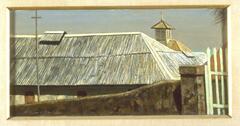31 UMMA Objects
31 UMMA Objects
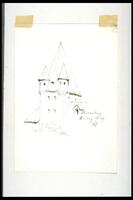
Warren Lombard (American (North American))
'Rothenburg Sketches' (and Nuremberg) II. Nuremberg
1889
Gift of Prof. and Mrs. Alfred H. White
1940.316
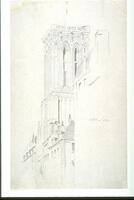
Albert Kahn (American (North American))
Caen
10/18/1891
Transferred from the College of Architecture and Design, 1972—Gift of the Family of Albert Kahn: through Dr. Edgar A. Kahn; Mrs. Barnett Malbin; Mrs. Martin L. Butzel
1972/2.587
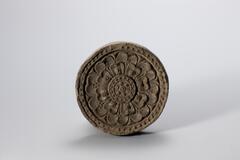
Korean (Korean (culture or style))
Roof-end tile with lotus design
676 – 935
On loan from the YooGeum Museum, Seoul, Korea
LTL2009.7.7
![This curved tile has small circles lining the edge of the two long, curved edges, and two shorter straight edges without special border decoration. The face of the tile is decorated with vegetal arabesque motif.<br />
<br />
This gray-white, low-fired earthenware concave eave-end roof tile features a scroll design. Although each motif on the front decorative surface of the tile is different, the scroll design demonstrates some degree of left-right symmetry. Traces of a parallel pattern made by a paddle four centimeters wide are visible on the flat surface of the tile. Traces of trimming and smoothing with water are also visible on the sides and joints.
<p>[Korean Collection, University of Michigan Museum of Art (2017) p. 40]</p>
This curved tile has small circles lining the edge of the two long, curved edges, and two shorter straight edges without special border decoration. The face of the tile is decorated with vegetal arabesque motif.<br />
<br />
This gray-white, low-fired earthenware concave eave-end roof tile features a scroll design. Although each motif on the front decorative surface of the tile is different, the scroll design demonstrates some degree of left-right symmetry. Traces of a parallel pattern made by a paddle four centimeters wide are visible on the flat surface of the tile. Traces of trimming and smoothing with water are also visible on the sides and joints.
<p>[Korean Collection, University of Michigan Museum of Art (2017) p. 40]</p>](/media/W1siZiIsIjIwMjEvMDIvMTkvOHh3OXdiaXozOV9kZWZhdWx0LmpwZyJdLFsicCIsInRodW1iIiwiMjQweDIwMCJdXQ?sha=c308a2996283af45)
Korean (Korean (culture or style))
Untitled
676 – 935
On loan from the YooGeum Museum, Seoul, Korea
LTL2009.7.11
![Earthenware roof tile-end with molded lotus design.<br />
<br />
This gray, high-fired earthenware convex eave-end roof tile features a slender thirteenpetal lotus design. It is made from coarse clay mixed with small stone particles. The circular ovary and lotus seeds are depicted in shallow relief, while the lotus petals are slender and lack volume.<br />
[Korean Collection, University of Michigan Museum of Art (2017) p.36] Earthenware roof tile-end with molded lotus design.<br />
<br />
This gray, high-fired earthenware convex eave-end roof tile features a slender thirteenpetal lotus design. It is made from coarse clay mixed with small stone particles. The circular ovary and lotus seeds are depicted in shallow relief, while the lotus petals are slender and lack volume.<br />
[Korean Collection, University of Michigan Museum of Art (2017) p.36]](/media/W1siZiIsIjIwMjIvMDkvMjQvOXVkYnJyYnlyaV9kZWZhdWx0LmpwZyJdLFsicCIsInRodW1iIiwiMjQweDIwMCJdXQ?sha=8f6c2bf6c7b8db77)
Korean (Korean (culture or style))
Roof Tile-End with Lotus Design
676 – 935
Gift of Bruce and Inta Hasenkamp and Museum purchase made possible by Elder and Mrs. Sang-Yong Nam
2004/1.196
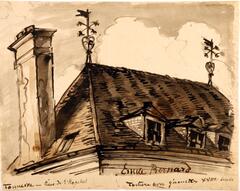
Emile Bernard
Tonnerre, Rue de l'hopital, Roof with Seventeenth-Century Weathervanes
1903 – 1941
Joseph F. McCrindle Collection
2009/1.530
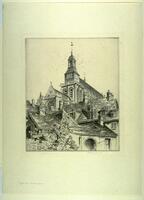
John Taylor Arms (American (North American))
Église Saint Gervaise, Gisors
1932
Gift of the Marvin Felheim Collection
1983/1.174
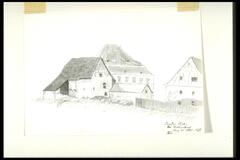
Warren Lombard (American (North American))
'Rothenburg Sketches' XIII. Tauber Thal bei Rothenburg
1889
Gift of Prof. and Mrs. Alfred H. White
1940.326
![This lotus medallion design on this round tile-end consists of eight petals. The outer rim is decorated with eighteen round dents. The seedpod contains six peripheral seeds.<br />
<br />
This gray, high-fired earthenware convex eave-end roof tile features a single-tier lotus design. It is made from fine clay mixed with a small amount of sand and is robust in appearance. The central ovary and petals of the lotus stand out in relief. The rim displays a “pearl-dot” (<em>yeonju</em> ) motif depicted in intaglio.<br />
[Korean Collection, University of Michigan Museum of Art (2017) p.36] This lotus medallion design on this round tile-end consists of eight petals. The outer rim is decorated with eighteen round dents. The seedpod contains six peripheral seeds.<br />
<br />
This gray, high-fired earthenware convex eave-end roof tile features a single-tier lotus design. It is made from fine clay mixed with a small amount of sand and is robust in appearance. The central ovary and petals of the lotus stand out in relief. The rim displays a “pearl-dot” (<em>yeonju</em> ) motif depicted in intaglio.<br />
[Korean Collection, University of Michigan Museum of Art (2017) p.36]](/media/W1siZiIsIjIwMjIvMDkvMjQvMmdrajdidWp4Ml9kZWZhdWx0LmpwZyJdLFsicCIsInRodW1iIiwiMjQweDIwMCJdXQ?sha=9077af1495ff16b4)
Korean (Korean (culture or style))
Roof Tile
676 – 935
Gift of Bruce and Inta Hasenkamp and Museum purchase made possible by Elder and Mrs. Sang-Yong Nam
2004/1.197
![This is an example of a lotus medallion with a double layer of petal. Two rows of eight petals each are arranged around a double-ring seedpod. The outer ring of the seedpod has no design. The inner ring of the seedpod contains a central seed surrounded by six peripheral seeds (1+6 seed pattern). The outer rim is embellished with a bead pattern.<br />
<br />
This gray-white, high-fired earthenware concave eave-end roof tile with an eight-petal lotus design was made from fine clay mixed with a small amount of sand. The reverse side shows signs of having been joined to a flat tile, while traces of trimming and smoothing with water are also visible. The round ovary is circumscribed by double lines and contains seven seeds: one in the center surrounded by six more.<br />
[Korean Collection, University of Michigan Museum of Art (2017) p.37] This is an example of a lotus medallion with a double layer of petal. Two rows of eight petals each are arranged around a double-ring seedpod. The outer ring of the seedpod has no design. The inner ring of the seedpod contains a central seed surrounded by six peripheral seeds (1+6 seed pattern). The outer rim is embellished with a bead pattern.<br />
<br />
This gray-white, high-fired earthenware concave eave-end roof tile with an eight-petal lotus design was made from fine clay mixed with a small amount of sand. The reverse side shows signs of having been joined to a flat tile, while traces of trimming and smoothing with water are also visible. The round ovary is circumscribed by double lines and contains seven seeds: one in the center surrounded by six more.<br />
[Korean Collection, University of Michigan Museum of Art (2017) p.37]](/media/W1siZiIsIjIwMjIvMDkvMjQvNWQ2NmVjeHQzYl9kZWZhdWx0LmpwZyJdLFsicCIsInRodW1iIiwiMjQweDIwMCJdXQ?sha=4c7124ce9509ddf0)
Korean (Korean (culture or style))
Roof Tile
676 – 935
Gift of Bruce and Inta Hasenkamp and Museum purchase made possible by Elder and Mrs. Sang-Yong Nam
2004/1.198
![Circular earthenware tile with molded lotus and bosangwha design.<br />
<br />
This dark gray, high-fired earthenware convex eave-end roof tile is decorated with an eight-petal lotus floral medallion. It is made from coarse clay mixed with fine stone particles. The center of the tile is decorated with a double-petaled lotus flower surrounded by eight heart-shaped palmette petals (bosanghwa ) in low relief. Traces of clay used to attach this tile to a flat tile can also be seen on the joints of the reverse side.
<p>[Korean Collection, University of Michigan Museum of Art (2017) p. 39]</p>
Circular earthenware tile with molded lotus and bosangwha design.<br />
<br />
This dark gray, high-fired earthenware convex eave-end roof tile is decorated with an eight-petal lotus floral medallion. It is made from coarse clay mixed with fine stone particles. The center of the tile is decorated with a double-petaled lotus flower surrounded by eight heart-shaped palmette petals (bosanghwa ) in low relief. Traces of clay used to attach this tile to a flat tile can also be seen on the joints of the reverse side.
<p>[Korean Collection, University of Michigan Museum of Art (2017) p. 39]</p>](/media/W1siZiIsIjIwMjIvMDkvMjQvM255Z3pueDhnNl9kZWZhdWx0LmpwZyJdLFsicCIsInRodW1iIiwiMjQweDIwMCJdXQ?sha=7079d07ccd567174)
Korean (Korean (culture or style))
Roof Tile-End with Lotus and Bosanghwa Design
676 – 935
Gift of Bruce and Inta Hasenkamp and Museum purchase made possible by Elder and Mrs. Sang-Yong Nam
2004/1.201
Loading…
